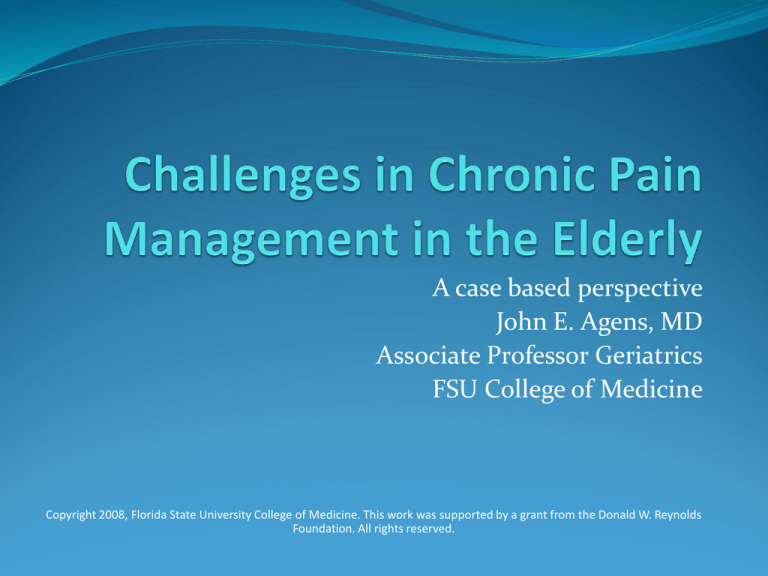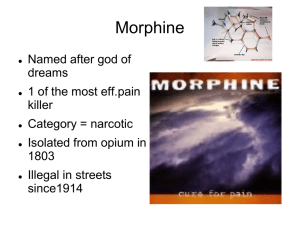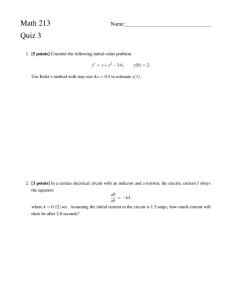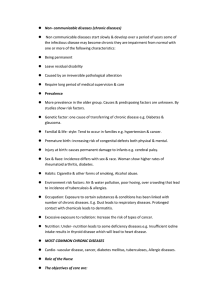
A case based perspective
John E. Agens, MD
Associate Professor Geriatrics
FSU College of Medicine
Copyright 2008, Florida State University College of Medicine. This work was supported by a grant from the Donald W. Reynolds
Foundation. All rights reserved.
Objectives
Know common risks of medication options for
moderate chronic non-malignant pain in the context
of medical comorbidities common in elderly patients.
Begin to approach and manage dosage increases of
long acting opioid pain medication in the context of
more severe chronic pain in a palliative setting.
Use functional improvement as part of a care plan for
a patient who requires opioid therapy where there is
provider concern about development of addiction.
Discuss adjuvant pain meds for herpes zoster pain.
Today’s Agenda
We will divide into four small groups for 8-10 minutes.
Each group will discuss a case and some questions.
There may be more than one correct option.
We will then reconvene to discuss all four cases.
Case I: Osteoarthritis Pain
A 73 year old female has osteoarthritis of the knees, hips,
and spine present for years but worse for six months.
She has three stairs to climb into her three story home.
It is so painful to do this and transfer in and out of the
car that she is minimizing going out.
Acetomenophen 1000mg every 6 hours on a schedule no
longer works as well as it did. Pain is ranked 5/10
throughout the day while awake and 8/10 during the
above mentioned activities. She refuses joint
replacement.
Consider options
A walking program plus one of the following:
add propoxyphene every six hours
add tramadol 50 mg every six hours
change to ibuprofen 600mg every six hours
change to celexocib 100mg daily
add codeine 30mg every six hours plus daily senna
add hydrocodone 5mg every six to eight hours prn
add oxycodone 5mg every six hours plus daily senna
World Health Organization
Pain Management
“Ladder”
Non-opiate;
+ / - Adjuvant
Aspirin, NSAID,
Acetaminophen
Step 1
Mild Pain
MODERATE Opiate
Plus Non-opiate;
+ / - Adjuvant
Codeine
Hydrocodone
Tramadol
Oxycodone
Step 2
Moderate Pain
POTENT Opiates Plus
Non-opioid; + / - Adjuvant
Morphine
Hydromorphone
Methadone
Fentanyl
Step 3
Severe Pain
Medical Co-Morbidities
Congestive heart failure from ischemia on lisinopril/HCTZ
20/25mg well compensated but with 1+ chronic edema.
Chronic atrial fibrillation on warfarin 5mg daily
Depression on sertraline 150mg daily
Chronic renal failure with estimated CrCl of 40ml/min
Past medical history of gastric ulcer, h. pylori negative.
Do the above co-morbidities lead one to
narrow the choices from the earlier slide?
Propoxyphene and Tramadol
Propoxyphene is metabolized to nor-propoxyphene a
cardiotoxic, non-opioid metabolite. American Journal of
Therapeutics “Propoxyphene (Dextropropoxyphene): A Critical Review of a Weak Opioid
Analgesic That Should Remain in Antiquity” Barkin RL, et. al. 13(6) 2006 pp 534-542
Tramadol in combination with serotonin reuptake
inhibitors risks development of serotonin syndrome.
British Journal of Clinical Pharmacology “Uncovering the potential risk of serious
serotonin toxicity in Australian veterans using pharmaceutical claims data” July 2008 pp
1-8
Cox 2 Inhibitors and Kidney
Kidney adverse effects of the Cox 2 inhibitors are no
less common then they are with traditional NSAIDS
and, in the elderly, are as common as the GI side
effects.
Swan SK, Rudy DW, Lasseter KC et al. Effect of cyclooxygenase-2 inhibition on renal function in elderly
persons receiving a low-salt diet: A randomized,controlled trial. AnnIntern Med 2000;133:1–9
.
Drug
Concern
propoxyphene
Beer’s list drug, not better than
acetomenophen, toxic metabolites
tramadol
increased risk of seratonin syndrome
with SSRI’s like sertraline
ibuprofen
risk of worse CHF, renal function, and
GI bleeding
celexocib
risk of worse CHF, renal function, and
GI bleeding
codeine
constipation, short duration of action,
not a bad choice
hydrocodone as needed
prn less effective than scheduled
dosing
oxycodone
constipation, short duration of action
but does have a long acting form
Selected Guideline
Osteoarthritis Research Society International 2008
Sixteen experts from six countries and four disciplines
Guideline 20 “The use of weak opioids and narcotic
analgesics can be considered for the treatment of
refractory pain in patients with hip or knee OA, where
other pharmacological agents have been ineffective,
or are contraindicated. Stronger opioids should only
be used for the management of severe pain in
exceptional circumstances.”
Osteoarthritis and Cartilage Volume 16 Issue 2 Feb 2008 pp 137-162
Case II: Severe Chronic Pain
An 78 year old man with moderate to severe chronic lung
disease has, over the past year, developed severe pain in the
left hip due to aseptic necrosis from prednisone. Surgeons
will not operate because of the lung disease and chronic
renal failure from prior naproxen use. He uses a cane to
shift weight from the affected side which helps. Even so, he
requires morphine sulfate IR 30mg every four hours except
when he sleeps longer than four hours. Pain on awakening.
He ranks pain at 6/10 but it increases to 10/10 when he
walks. His children take turns dressing him and getting
him up daily. He can’t bend the hip without wincing.
Consider options
In addition to inquiring about medical power or attorney
for health care, living wills, and end of life care
preferences you choose to:
simply double the short acting morphine to 60mg q 4h
avoid further escalation of opoids because of the risk
add long acting morphine 80mg every 12 hours
add long acting morphine and double morphine IR
add amitriptyline 25mg at bedtime to morphine IR
switch to meperidine orally every four hours
Bad Options
meperidine is metabolized to normeperidine which
has toxic metabolites that are renally excreted
amitriptyline can cause orthostatic hypotension,
confusion, urinary retention, falls, and cardiac
arrhythmias and has very high anticholinergic activity
using only short acting opioids for severe chronic pain
Severe Pain in the Elderly
“… comorbidities—including cancer and noncancer pain, osteoarthritis,
rheumatoid arthritis, and postherpetic neuralgia—and patient
functional status need to be taken carefully into account when
addressing pain in the elderly.”
“no specific studies in the elderly have been performed, but it can be
concluded that opioids have shown efficacy in noncancer pain, which is
often due to diseases typical for an elderly population.”
“in practice, the art of medicine is realized when we individualize care
to the patient.”
Pergolizzi J, et. Al.“Opioids and the Management of Chronic Severe Pain in the Elderly: Consensus
Statement of an International Expert Panel with Focus on the Six Clinically Most Often Used World
Health Organization step III Opioids (Buprenorphine, Fentanyl, Hydromorphone, Methadone,
Morphine, Oxycodone)” Pain Practice Volume 8 Issue 4 pp287-313
Discussion questions
The patient decides he wants CPR and mechanical
ventilation in the event of a cardiopulmonary arrest. How
does this impact the decision making?
The patient is end stage with respect to the chronic
pulmonary disease. Given the patient’s wishes above,
would you still consider hospice for palliation?
After 3 weeks of MS Contin 80mg q 12h, pain is better but a
total of 30mg prn short acting morphine is still needed as
much as 3 X each day. What dosage of MS Contin now?
Case III: Addiction Concern
68 year old female has multiple symptomatic
osteoporotic compression fractures, a history of open
reduction and internal fixation of a hip fracture one
year ago, and several vertebroplasty operations which
failed to help her back pain. Self medicated w/ETOH.
She quit drinking alcohol after the hip surgery one year
ago. She partnered with a substance abuse counselor.
She attends AA on a regular basis. She smokes 2 packs
of cigarettes per day. She lives alone, no family near.
She takes a bisphosphonate, calcium, and vitamin D.
Case III: Addiction Concern
Initially the patient took oxycodone/APAP 5mg/325mg
every six hours. She was still in pain, but it improved
enough for her to catch up with her laundry and
housecleaning.
When her physician added oxycodone 12 hour long
acting formulation 10mg every 12 hours she was able to
do even more. When she inquired about a dosage
increase her physician told her she would need to find
another doctor.
The patient wants you to Rx. Write a plan for pain.
Federal Regulations
21 CFR 1306.07
May administer, prescribe or dispense a Schedule
II CS to a person with intractable pain, which no
relief or cure is possible or none has been found
after a reasonable effort.
This is the definition of a chronic pain patient.
Federal Regulations
21 CFR 1306.07
May treat acute / chronic pain with a Schedule II CS in a
recovering narcotic – addicted patient.
Federal law or regulations do not restrict the prescribing,
dispensing or administering of a narcotic medication to a
narcotic–addicted patient for the purpose of alleviating
pain, if such prescribing is medical appropriate within
standards set by the medical community.
One must keep good records to document the physician is
treating a pain syndrome, not the disease of narcotic addiction.
Plan of Care for Pain
PROBLEM
INTERVENTION
LOW ACTIVITY WALKING PROGRAM
GOAL
INCREASE FUNCTION
MODERATE
PAIN SCORE
OXYCONTIN q12 hours REDUCE PAIN to MILD SCORE and
WHILE INCREASING FUNCTION
ALCOHOLISM
CONTINUE AA
NEGATIVE RANDOM URINE TESTS
ADDICTION
RISK
DRUG CONTRACT
concerning timing of
med refills, not filling
lost prescriptions, etc.
NO REQUESTS FOR EARLY REFILLS
NO LOST PRESCRIPTIONS
EXPECTED OXYCONTIN IN BLOOD
MD DETERMINES PLAN SUCCESS
PSYCHBEHAVIOR
PSYCHOLOGY
ASSESSMENT/ PLAN
IMPROVED MOOD, RELAXATION,
PAIN BEHAVIOR
SOCIAL
ISOLATION
ENGAGE IN A SENIOR VENTURE OUTSIDE OF HOME
CENTER ACTIVITY
BEYOND NECCESSITIES
SMOKING
ASSESS READINESS
TO QUIT SMOKING
GOAL DEPENDING ON READINESS
CASE IV: NEUROPATHIC PAIN
A 77 year old healthy male has pain in the right chest
in a dermatomal distribution which is burning in
nature. He is recovering from shingles in that same
dermatomal distribution. He is getting only partial
relief from hydrocodone/APAP 10mg/ 500mg every six
hours. He is sleeping poorly because of the pain and
has lost five pounds because he is eating less two.
On physical exam he has a depressed mood and the
skin lesions from the shingles are healed. He has mild
BPH. He is on no other medications.
Consider Options
gabapentin 100mg three times a day, then titrating to
300mg three times a day.
duloxetine 30mg a day, then titrating to 60mg/ day
nortriptyline 10mg bedtime, titrating up as needed
pregabalin 50mg twice a day, then titrating to 100mg
Tyring, Stephen “Management of herpes Zoster and Postherpetic Neuralgia” Journal of the
American Academy of Dermatology 57(6) Supplement 1 Dec 2007 S136-162
DRUG
COST
SIDE EFFECTS
gabapentin
$60/ mo.
dizziness, somnolence,
ataxia, fatigue
duloxetine
$130/ mo.
nausea, dry mouth,
constipation, urinary
hesitancy, orthostatic
hypotension, somnolence
nortriptyline
$ 13/mo
orthostatic hypotension,
dizziness, dry mouth,
confusion, QT
prolongation
pregabalin
$73/ mo.
dizziness, somnolence,
ataxia, edema
Questions?



